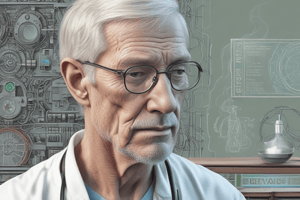Podcast
Questions and Answers
What does it mean if a patient is described as 'neurological'?
What does it mean if a patient is described as 'neurological'?
- The patient has active bowel sounds.
- The patient has a strong pulse.
- The patient has clear lung sounds.
- The patient is alert and oriented. (correct)
What describes 'breath sounds' in a normal assessment?
What describes 'breath sounds' in a normal assessment?
Regular rhythm bilaterally, even and unlabored.
In a respiratory assessment, non-labored breathing indicates a problem.
In a respiratory assessment, non-labored breathing indicates a problem.
False (B)
Which of the following is NOT a finding in a cardiac assessment?
Which of the following is NOT a finding in a cardiac assessment?
What characterizes peripheral vascular status?
What characterizes peripheral vascular status?
The integumentary system includes hair and nails.
The integumentary system includes hair and nails.
What is indicated by a musculoskeletal assessment showing a steady gait?
What is indicated by a musculoskeletal assessment showing a steady gait?
Which finding is associated with gastrointestinal (GI) assessment?
Which finding is associated with gastrointestinal (GI) assessment?
What does a genitourinary (GU) assessment indicate when a patient voids without discomfort?
What does a genitourinary (GU) assessment indicate when a patient voids without discomfort?
Flashcards are hidden until you start studying
Study Notes
Neurological
- Patient is alert and oriented with a Glasgow Coma Scale total of 15.
- Pupils are equal, round, and reactive to light.
- Cranial nerves II-XII are grossly intact.
- Oral examination shows intact teeth, moist mucous membranes, no cavities or bleeding.
- Patient swallows without difficulty and has symmetrical ears with a left ear piercing.
Breath Sounds
- Breathing exhibits a regular rhythm bilaterally, even and unlabored.
- No signs of shortness of breath present.
- Lung sounds are clear across all lobes both anteriorly and posteriorly.
Respiratory
- Patient experiences non-labored breathing without dyspnea, even upon exertion.
- Able to lie flat comfortably without tenderness or pain during palpation.
- Exhibits upright posture and steady gait; oxygen saturation is at 99%.
Cardiac
- Heart sounds S1 and S2 are regular and distinct at all five auscultation locations: Aortic, Pulmonic, Erbs, Tricuspid, and Mitral.
- No jugular vein distention or abnormal chest wall movement observed.
- Patient's extremities (arms and legs) are warm without edema.
- Maintains a normal sinus rhythm.
Peripheral Vascular
- Capillary refill time is less than 3 seconds indicating good perfusion.
- Pulses are palpable and strong, measured at 75 beats per minute (Carotid and Radial) with additional pulses assessed at Brachial, Femoral, Popliteal, Dorsalis Pedis, and Posterior Tibial.
- All pulses are even and described as 2+ in strength.
Integumentary
- Skin is intact, warm, dry, and quickly recoils back to normal.
- Skin color is appropriate for patient's race; hair is clean and evenly distributed.
- Nails are clean, short, with a capillary refill of less than 3 seconds.
- Patient has no tattoos or piercings aside from the left ear.
Musculoskeletal
- Patient maintains an upright posture with a steady gait.
- Muscle strength is rated at 5/5 bilaterally for grasp, dorsiflexion, and plantar flexion.
- Symmetry in muscular structure is noted across both upper and lower extremities with no gross deformities.
Gastrointestinal (GI)
- Bowel sounds are hypoactive in the right upper quadrant (RUQ), left upper quadrant (LUQ), right lower quadrant (RLQ) and hyperactive in the left lower quadrant (LLQ).
- Patient reports soft, brown stools that test negative for blood.
- Swallowing is reported without difficulty.
Genitourinary (GU)
- Patient is continent and voids without discomfort.
- Urine is clear, with no odor or cloudiness, and the patient empties the bladder without difficulty.
Studying That Suits You
Use AI to generate personalized quizzes and flashcards to suit your learning preferences.





